

The system is intended to let animators iterate more quickly than with traditional Playblasts: as well as simply being faster, a shot can now be played back from any camera angle without re-caching. Rig evaluation is based on OpenCL, so GPU processing should work on both AMD and Nvidia hardware.

Users can set a target frame rate for playback, and choose whether caching targets the CPU or GPU. One new feature intended to do both is the new cached playback system, which makes it possible to scrub through animations in the viewport without having to wait for Maya to update and redraw the scene.Ĭaching is enabled by default, and works continuously in the background, updating only those frames in the cache that are affected by recent changes. Speaking to CG Channel before the launch, Autodesk described two of the key objectives for Maya 2019 as improving animation workflow and improving performance. New cached playback system provides a more interactive alternative to Playblasts The update focuses primarily on animation workflow and performance, adding a new cached playback system to supplement traditional Playblasts, and improving scene loading times in Viewport 2.0.Īutodesk has also shipped Maya LT 2019, a parallel update to the cut-down edition of Maya for game artists and Mudbox 2019 and MotionBuilder 2019: new versions of its digital sculpting and mocap editing tools. Autodesk has released Maya 2019, the latest version of its 3D modelling and animation software.


 0 kommentar(er)
0 kommentar(er)
